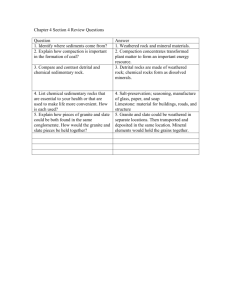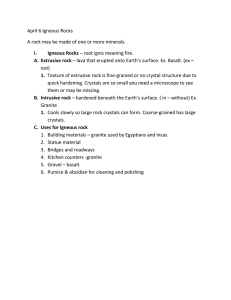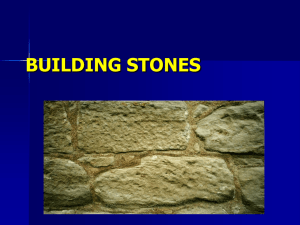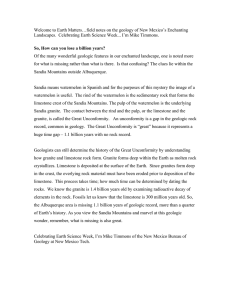CITY OF LONDON CEMETERY TEACHERS’ GUIDE TO ROCK TYPE EXERCISES: LOCATION TWO
advertisement
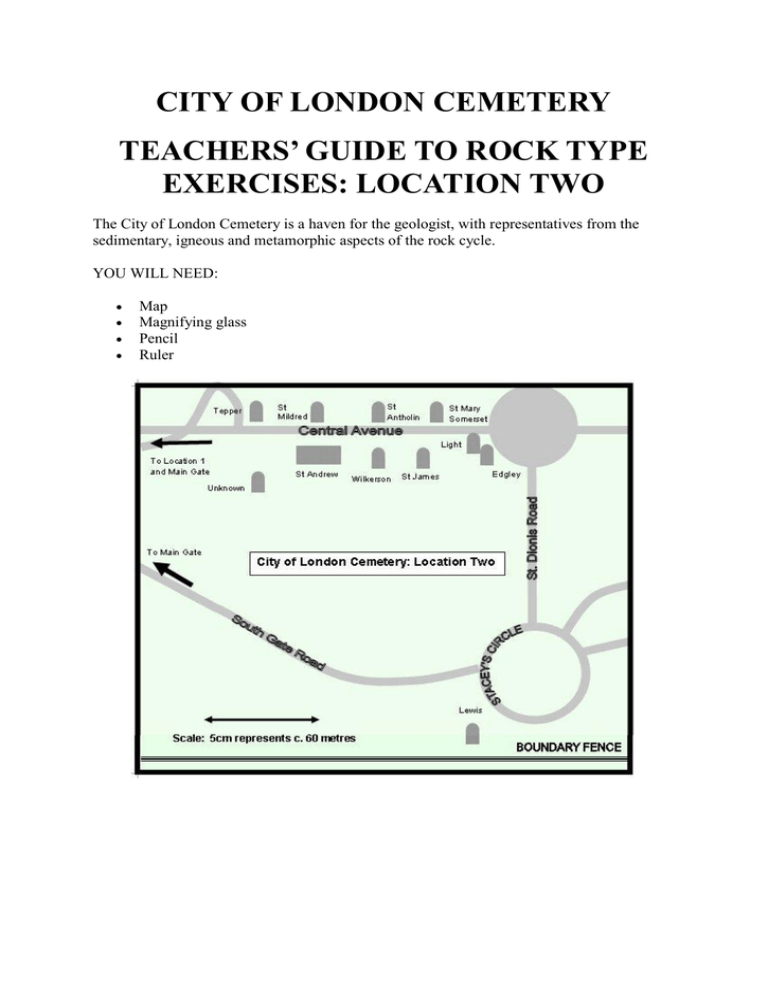
CITY OF LONDON CEMETERY TEACHERS’ GUIDE TO ROCK TYPE EXERCISES: LOCATION TWO The City of London Cemetery is a haven for the geologist, with representatives from the sedimentary, igneous and metamorphic aspects of the rock cycle. YOU WILL NEED: Map Magnifying glass Pencil Ruler Instructions You have four different rock types to study and answer questions about, given in the following sheets. The rocks are: limestone, marble, granite and sandstone. You will need the map to help you find the right gravestone, and you will be able to see the rock better if you use a magnifying glass. It is best to hold the magnifying glass up to your eye, and then move your head close to the rock, trying not to cast your shadow over it. In order to answer the questions, you may have to look at all sides of the gravestone. The ruler is needed to make a scale on your drawings (you may wish to draw an enlarged picture), and also to measure crystal sizes. LIMESTONE 1. Go to the memorial to St. Helen’s, Bishopsgate (see map). The pale, cream-coloured rock, of which it is mostly composed, is limestone. Is the limestone made of crystals which lock into each other (a bit like a jigsaw), or is it made of grains with spaces (pores) between them? Circle the correct answer below. Crystals? Or grains? Does this mean that the rock is igneous or metamorphic (interlocking crystals), or sedimentary (made of grains)? 2. Can you see any fossils in the rock? Yes/No If so, are they whole or broken? Broken Do you think these fossils are: a) plants? Yes/No b) vertebrates (animals with a backbone)? Yes/No c) invertebrate (e.g. insects, snails) Yes/No What do these fossilized creatures remind you of? Remember you are looking at them in two dimensions. Think what they might look like in 3D. They look like shells that you find on the beach. Where do you think they might have lived? In the sea. What does this tell you about where the limestone was formed? The limestone was formed by deposition (of calcium carbonate) on the sea-floor. The sediments incorporated sea shells, which were then fossilized. 3. Describe the limestone forming St. Helen’s, in terms of the following, by filling in the table below: Colour (make sure you look at a clean face) grain-size (can you measure it? Can you see it with your naked eye, or do you need a magnifying glass?) fossils (you should have described these already, above) sketch (Remember to add a scale to your drawing, and label any fossils) You will be able to fill in the name and age of the rock later. Property St. Helen’s Bishopsgate St. Mildred Poultry Colour cream grey Grain size Fine-grained Medium-grained Fossils Yes/No Yes/No Sketch Name of Limestone Portland Limestone Carboniferous Limestone Geological Age Jurassic Carboniferous Age in years 135,000,000 330,000,000 Now make your way to St. Mildred Poultry, the dark grey rock in the shape of a Celtic cross. This is a different limestone. Look at it carefully, just as before, and fill in the table above in the same way. Now identify the names and ages of the rocks, from their fossil content (see over for key). Fossil oysters in Portland Limestone, Jurassic age, 135,000,000 years old Fossil crinoids in Carboniferous limestone, Carboniferous age, 330,000,000 years old MARBLE Marbles are limestones that have been altered by high temperatures and/or pressures. This process is known as METAMORPHISM, and marble is a METAMORPHIC rock. Sometimes the word marble is used by stonemasons to mean any rock that can take a polish, which is not the same definition as a geologist would give! There are a number of examples of marble along Central Avenue . We will be looking at a fresh example, and also a weathered one. Sometimes the way a rock weathers can help you to identify it. 1. Compare the marble of the St. Antholin memorial (probably put up in the late 1870s) with a younger example, such as that of Pearce, three gravestones to the left, or the white angel commemorating Steng, near the eastern (far) end of the road. Use the table below to fill in your observations on the two memorials, looking at the following properties: Colour Fossil content (if there is any) Appearance and feel (check vertical and horizontal surfaces; smooth or bumpy? Look along the surface – smooth or rough? Why?) Property Pearce St. Antholin (weathered) (fresh) Date on memorial 1875 1921 Colour of clean face Cream White with grey streaks Fossils None None General appearance and feel Coated with greenish lichen, circular on horizontal surfaces, evenly coated on vertical ones. Shows bumps and ridges where parts have been chemically weathered (acid rain?). Grains can be stroked away. Smooth to touch. Slightly speckled grey from atmospheric pollutants; possibly a little lichen. GRANITE What type of rock is granite? SEDIMENTARY IGNEOUS METAMORPHIC (circle correct answer) There are several distinct types of granite in the cemetery. Make your way to the black and white memorial cross to George Wilkerson (see map – it’s in the third row back from the roadway, near to the big St. Andrew memorial). Note: there are several other monuments in this location which show the same excellent granite, with tabular feldspars that are good for measuring. Mineralogy You should be able to see three different types of mineral in granite: FELDSPAR = Pink or white crystals with large rectangular outlines, often crossed by fine parallel cracks known as “cleavage”. QUARTZ = Grey or colourless irregularly shaped crystals with a glassy appearance. MICA = Black and/or silver flakes o Black flakes – BIOTITE MICA o Silver flakes – MUSCOVITE MICA (not visible in polished granites) 1. Check that you can identify these minerals in the two granite memorials. Quartz is otherwise known as SILICON DIOXIDE. 2. What is its chemical formula? SiO2 Sketches Sketch of the minerals in granite Drawing courtesy of Dr Eric Robinson, UCL 3. Draw an area of granite yourself, identifying and labelling all three minerals and any features about them that you feel are important. Use the example sketch given to you for help in identification. Granite Sketch Don't forget to add a scale! Grain size The granite you are examining is EQUIGRANULAR, i.e. all the crystals are roughly the same size. Rocks can have different grain sizes depending on how they formed. There are three main types, termed simply as: COARSE GRAINED – crystal diameters >5mm MEDIUM GRAINED – crystal diameters = 1–5mm FINE GRAINED – crystal diameters <1mm Let’s find out the grain size for this granite… 4. Using a ruler, measure the lengths of 5 feldspar crystals (use feldspar crystals because they have the most regular shape and distinct long axes that can be easily compared): Length of feldspar crystal: 1. 12mm 2. 13mm 3. 18mm 4. 10mm Average = 16.6 mm 5. 20mm From your average feldspar crystal length, do you think this is a coarse, medium or fine grained rock? Why? Coarse. Granite is coarse grained, because the melt cools slowly as it intrudes the crust, and the crystals form over a long time. Where a melt is extruded at the surface, crystals form quickly and are small (e.g. a basalt). Now make your way to the Tepper memorial, also composed of granite but containing pink feldspar crystals. Xenoliths 5. This granite probably comes from Peterhead in Scotland . Can you see any patches within the pink granite that look different from the surrounding rock? What distinguishes them from the rest of the granite? They are darker in colour and finer grained What shape are they? They are irregular in shape and rounded at the edges (Check that it is not dirt or lichen that you are looking at!) These are XENOLITHS (Greek word for “strange rock”). Xenoliths are blocks of country rock (the rock into which the granite would have been intruded when molten) that were dislodged by the intrusion and “fell” into the hot magma. Originally the blocks would have been angular in shape but the hot magma would have caused the edges to melt and became more rounded. Draw an example of a xenolith, noting its size and its rounded edges. Try to point out how it is different from the surrounding granite, but don’t worry about its mineral content! Xenolith Sketch Don't forget to add a scale! SANDSTONE Make your way to the buff/orange coloured and badly weathered sandstone grave, where the inscription has partly fallen away. To find it, start by facing the large memorial to St. Andrews . Walk about 25 metres along the road to the right of it, and then turn to your left and walk 8 rows back. Do not touch the gravestone more than necessary, as it is very crumbly. 1. Sandstone is formed by the cementing together of grains of sand. Does this make it sedimentary, igneous or metamorphic? Sedimentary 2. This memorial is made of buff-coloured sandstone. Would you say that the sandstones are coarse grained, medium grained or fine grained? (Use the same criteria that you did for granite). Fine-grained 3. This rock is badly weathered. Describe how it is weathering. Is it the same all over? The sandstone is flaking away parallel to the face of the memorial, and flakes have come away very unevenly. The sandstone underneath is pink rather than orange, and crumbly. 4. Do you think that this is caused by physical, chemical or biological weathering? Physical, although the grains below the surface may have been loosened through the action of water between the grains. 5. Sketch of the whole gravestone, marking on the weathered surfaces: Gravestone Sketch Don't forget to add a scale! And finally…………. Using your map, find the following memorials and label the different materials they are made from, using terms from the list below: GRANITE (PINK) GRANITE (GREY) LIMESTONE SANDSTONE (BUFF) SANDSTONE (RED) MARBLE BRICK/TILE 1. St. Mary Somerset 2. St. Andrews 3. Edgley


